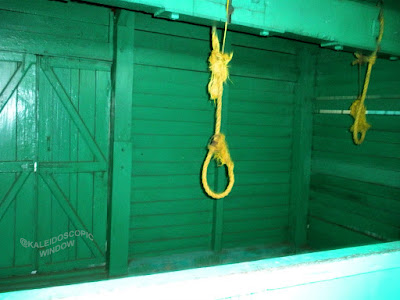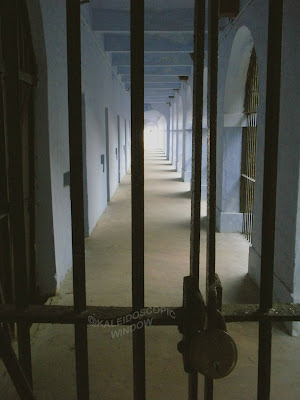Over the years, I have learned
that 'Freedom is never free.' Freedom costs us more than just sweat and blood
or whatever we are forced to give. It costs us the lives of our
fathers, our sisters and brothers and many more. But while freedom is never
free, we have to remember that, it has been bought at a great price and with it comes to great responsibility. As I stepped inside the great yet
notorious cellular jail, a chill gone down my spine. And soon I
realized that what actually freedom means. The twilight hush, the lazy evening
sky, and a retiring sun may set our mind free but the boundary wall won’t let
you go too far. As if, I am a kite but my movement is maneuvered by the
invisible kite man. Though there were many visitors still I felt alone. The
corridors, now echoing with the juvenile chirps of the young ones. But the
silent screams of our brave heroes could be heard.
 |
| Amar Jyoti: The Eternal Flame |
 |
| Memorial to honor the first World War Indian soldiers and the Freedom Fighters |
Cellular Jail in Andaman and Nicobar Islands, India, stands as a dark reminiscence of the British rule in the Indian subcontinent. This most dreaded and grueling colonial prison situated in the remote archipelago was used by the British particularly to exile Indian political prisoners. Isolated from the mainland, this jail, also referred to as Kala Pani (where Kala means death or time and Pani means water in Sanskrit) witnessed the most atrocious punishments imposed on prisoners. India’s struggle for independence saw imminent freedom fighters like Batukeshwar Dutt and Veer Savarkar being incarcerated in this jail. The jail, completed in the year 1906 acquired the name ‘Cellular’ because it is entirely made up of individual cells for solitary confinement. It originally was a seven prolonged, puce-colored building with central tower acting as its fulcrum and a massive structure comprising honeycomb like corridors. The central tower had a large bell for raising alarm and also during someone going in gallows. The building was subsequently damaged and presently three out of the seven prongs are intact. The Jail, now a place of pilgrimage for all freedom-loving people, has been declared a National Memorial. The jail museum here draws your memories back to those years of freedom struggle.
 |
| The path to History |
 |
| The Tower |
 |
| Those ropes and.... |
It
was my fourth visit to the jail, yet every time I feel, there are more stories
to come out, need to be told. But, who will tell us? The inmates had been
killed or might had been silenced by the stroke of time. Only this mute
spectator, the Jail, standing along with the Peepal tree, and without uttering
a single word telling a lot that mere words can describe. Tears were rolling
down the cheeks, grief and sadness engulphed my heart. I was eagerly showing my
kids every corner of the cells and corridors and telling the stories I have
heard earlier.
 |
| Our past laid behind this lock... |
 |
| So many stories... |
 |
| The chair of notorious General Barry |
 |
| Oil machine for coconut oil..... But in place of a bull, our freedom fighters were made to do the bull work |
The freedom fighters in hundreds were sent to the island where they remained
under the custody of jailer David Barry and military doctor Major James
Pattison Walker. Notable freedom fighters confined in the jail included
Batukeshwar Dutt, Diwan Singh Kalepani, Fazl-e-Haq Khairabadi, and the Savarkar
brothers - Babarao Savarkar and Vinayak Damodar Savarkar among others. Being in
solitary confinement the Savarkar brothers were unaware of each other’s
presence in the same jail for two years. Many freedom fighters in the jail went
through inhuman and unimaginable tortures, the very thought of which brings
chills down the spines. The jail drew attention when its inmates observed
hunger strikes in the early 1930s. Bhagat Singh’s associate in the freedom
movement, Mahavir Singh went on a hunger strike in protest of such cruel
treatment but died when authorities tried to feed him milk forcibly which went
to his lungs. His body was thrown into the sea. In 1937-38 following
intervention by Mahatma Gandhi and Rabindranath Tagore the government decided
on repatriating the freedom fighters.
 |
| From the Roof |
My kids were pretty shaken seeing
the rough clothes meant for the prisoners and the torture tools used by General
Barry. But they should know that the freedom they are enjoying didn't come
easy. They are standing on the sweat, blood, and flesh of our freedom fighters.
The road was never easy, it wasn't meant to be.
Some quick note on Cellular Jail:
When was it built: From 1896 to
1906
Who built it: British
Time took: 10 years
Where is it located: Port Blair,
the capital city of the Andaman and Nicobar Islands, India
Why was it built: As Solitary
Confinement
Architectural Style: Cellular,
Pronged
Visit Timing: 9.00 am to 12.30
pm, 1.30 pm to 4.45 pm
How to Reach: Port Blair is
well-connected with many cities of mainland India by sea and air.
Light & Sound Show
It regularly holds Light &
Sound (Son-et-Lumiere) shows on India’s freedom struggle in Hindi and English
excepting on every Monday, Wednesday, and Friday. The price of a ticket for The light and sound show is Rs. 50/- per adult. (rates may be revised)
P.S. I have visited the place in
2019, 2009, 1993, 1992
If you like my write up, Do not
forget to follow me for more, leave your feedback and feel free to share with
your friends with the hashtag #kaleidoscopicwindow.
@anindita



No comments:
Post a Comment